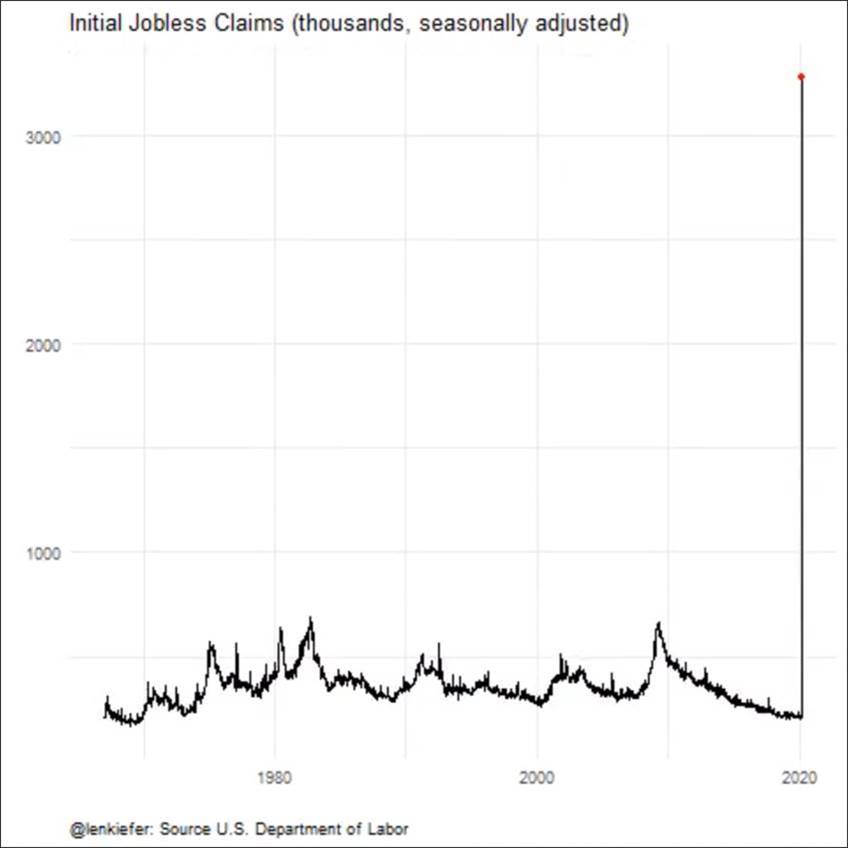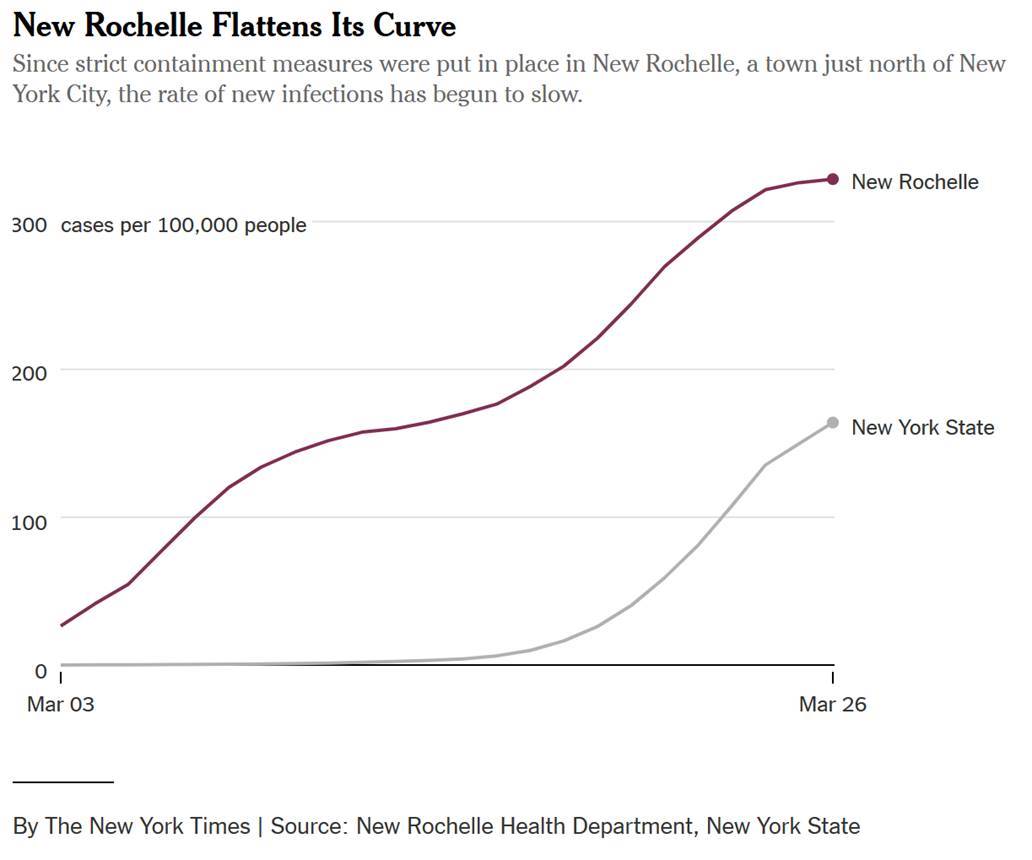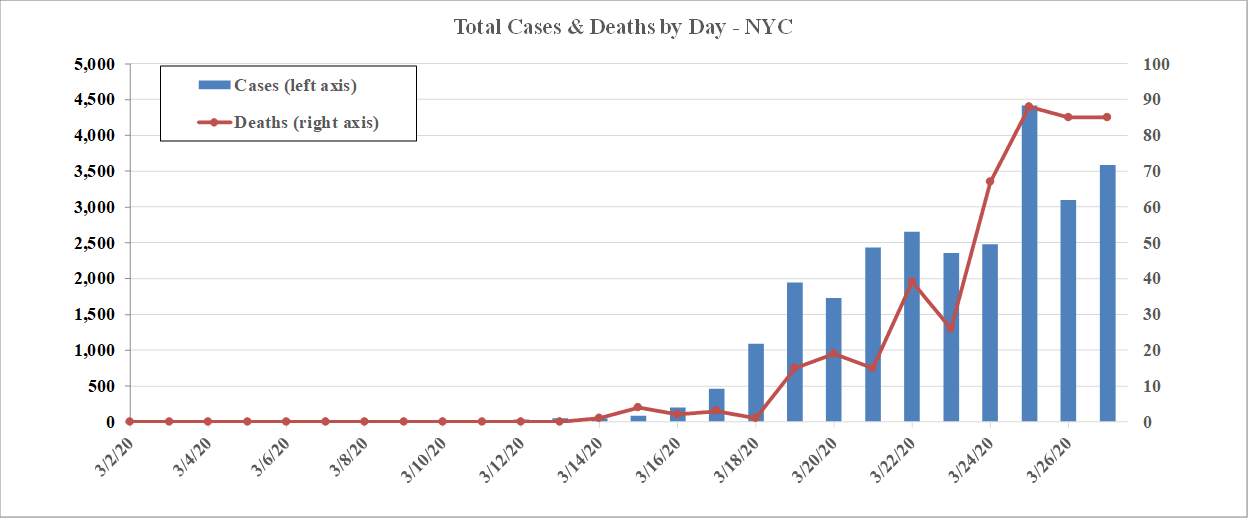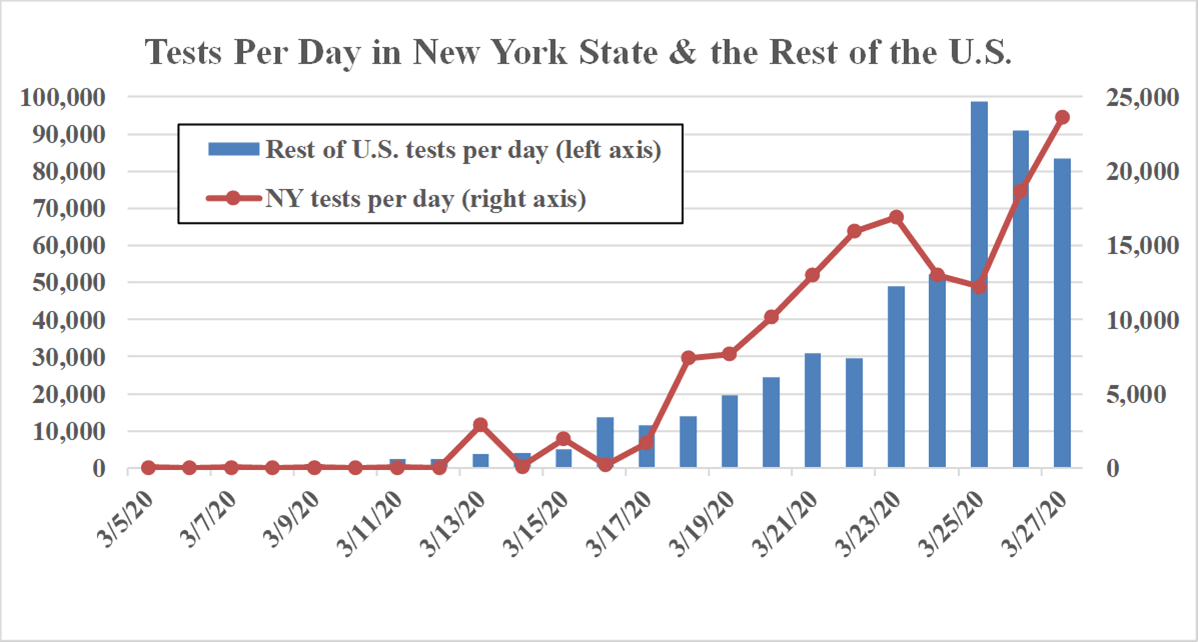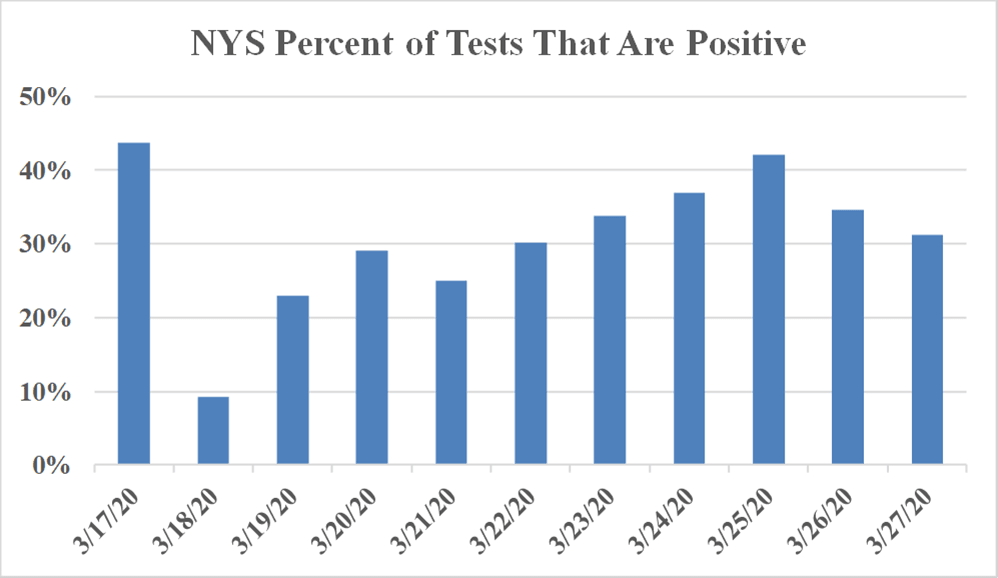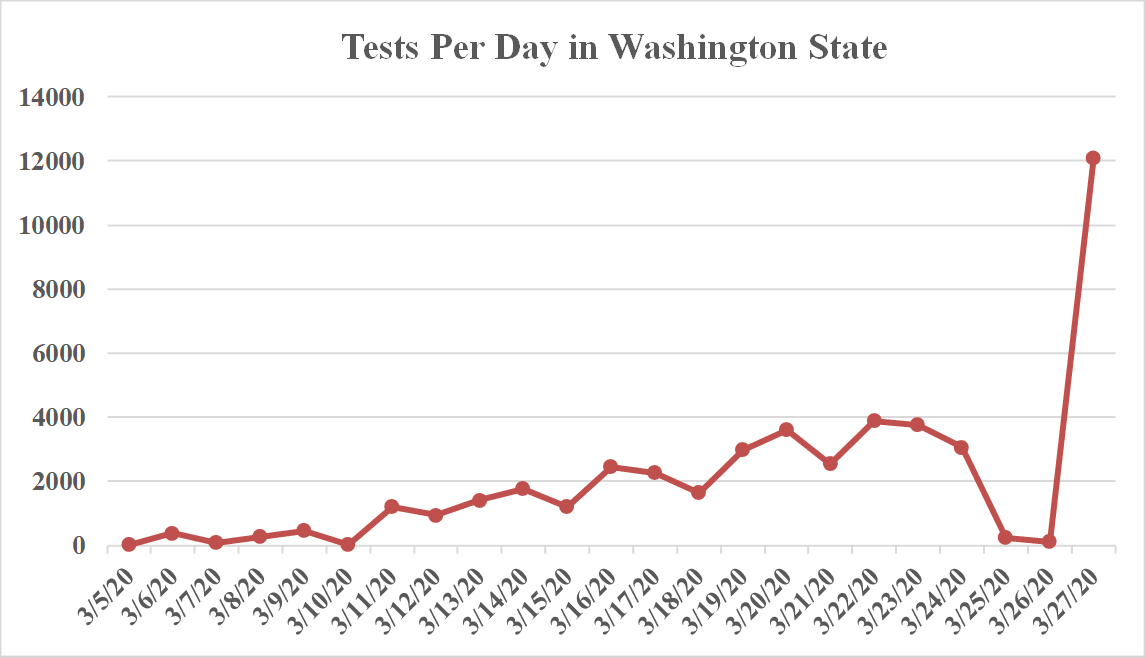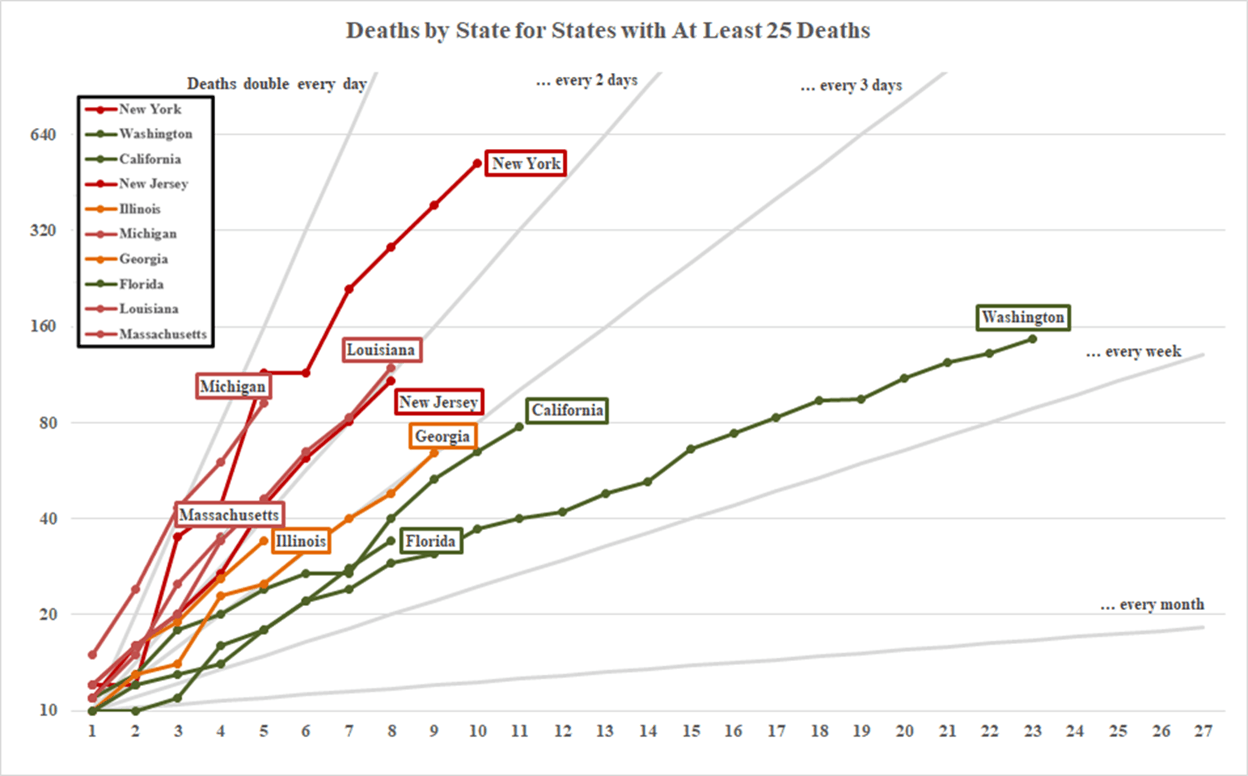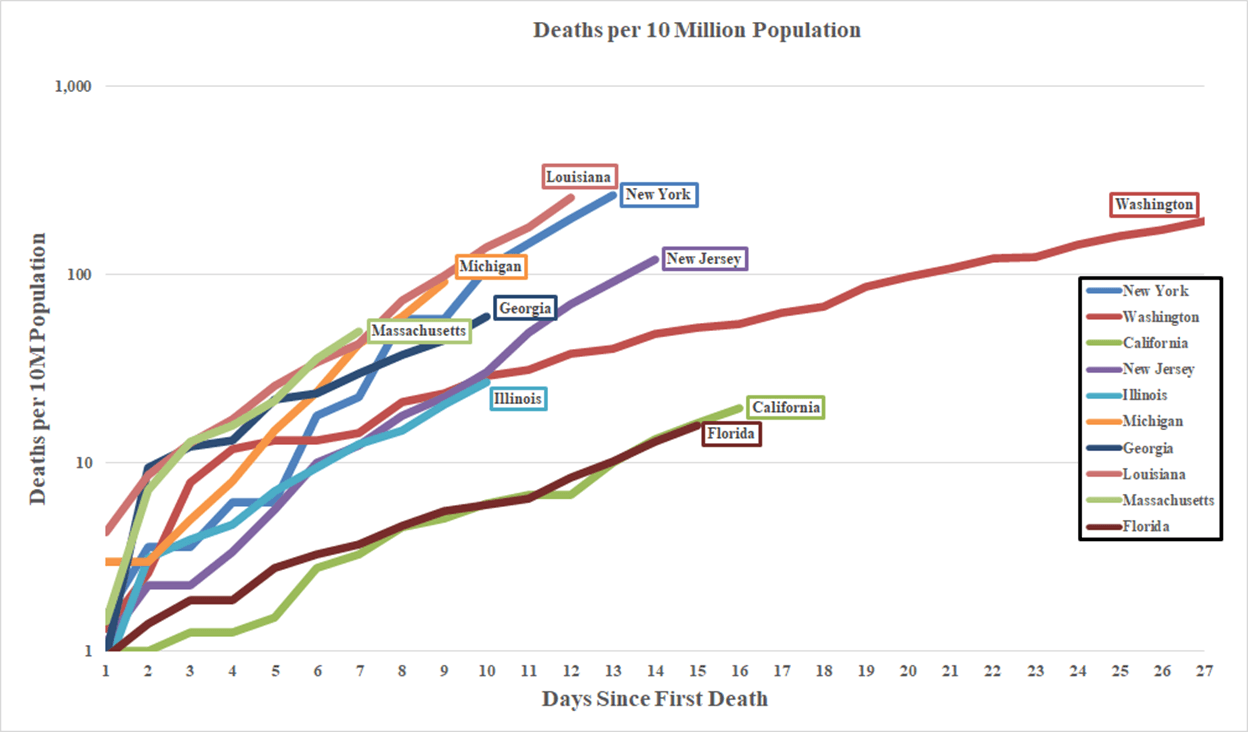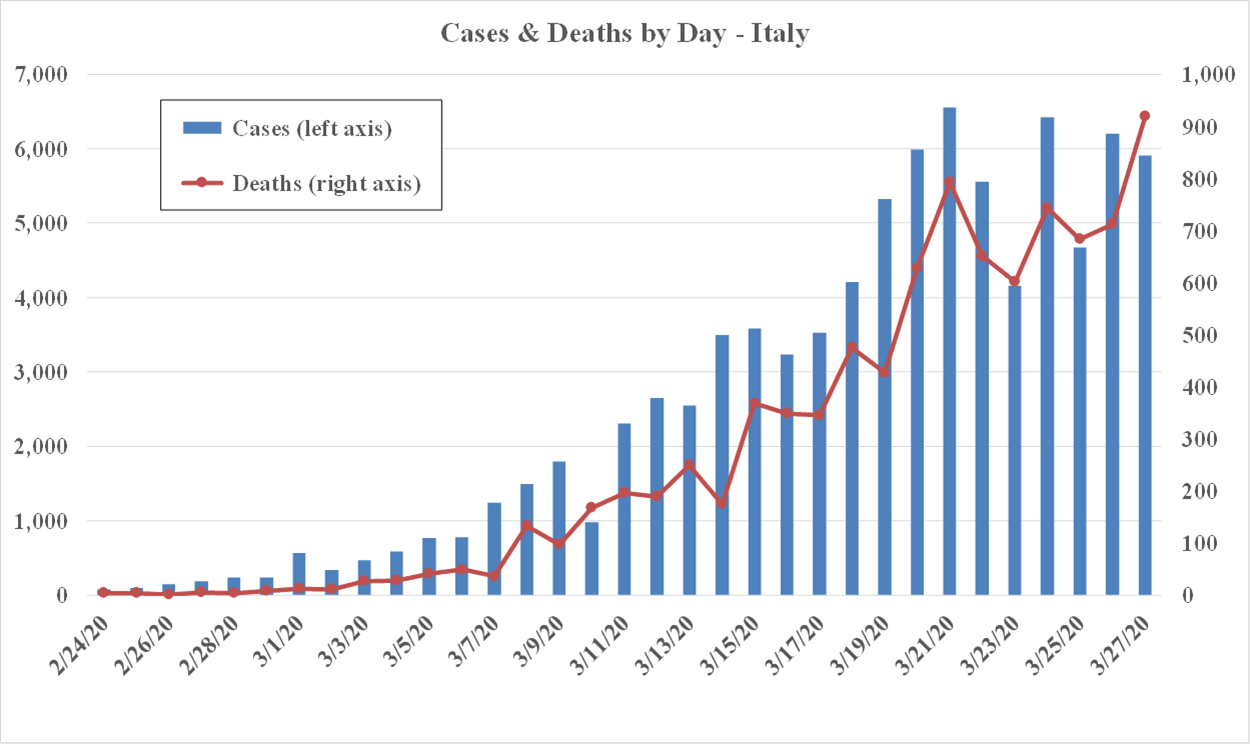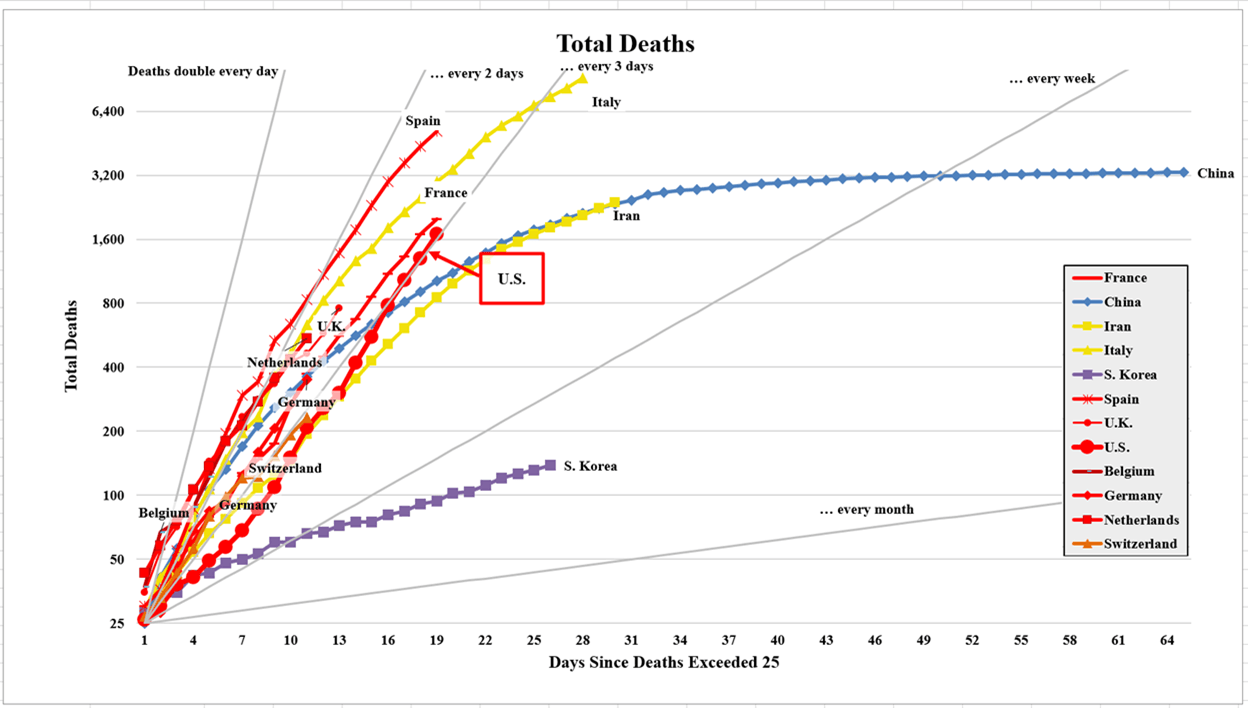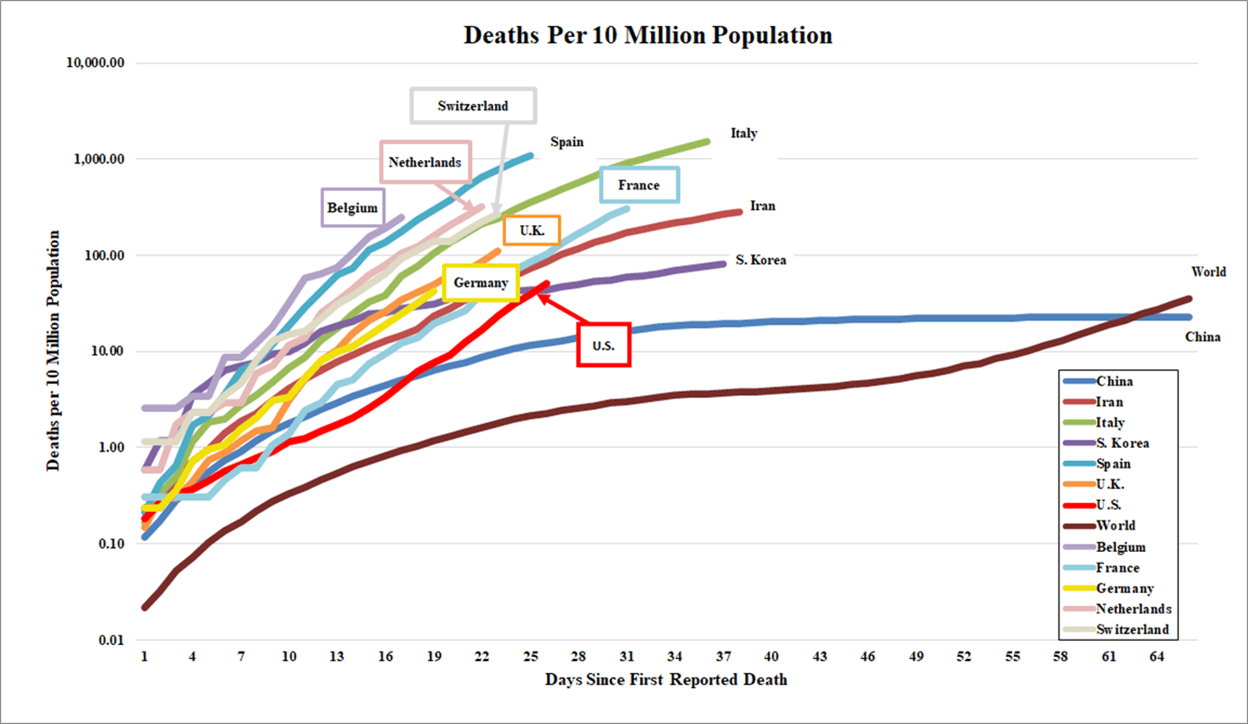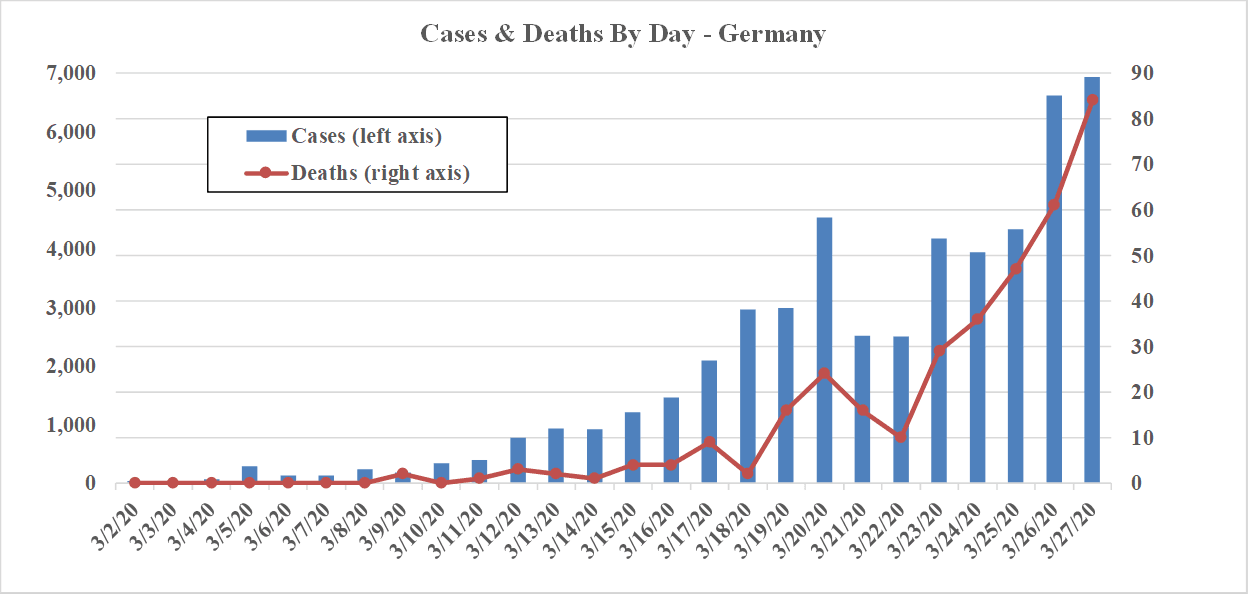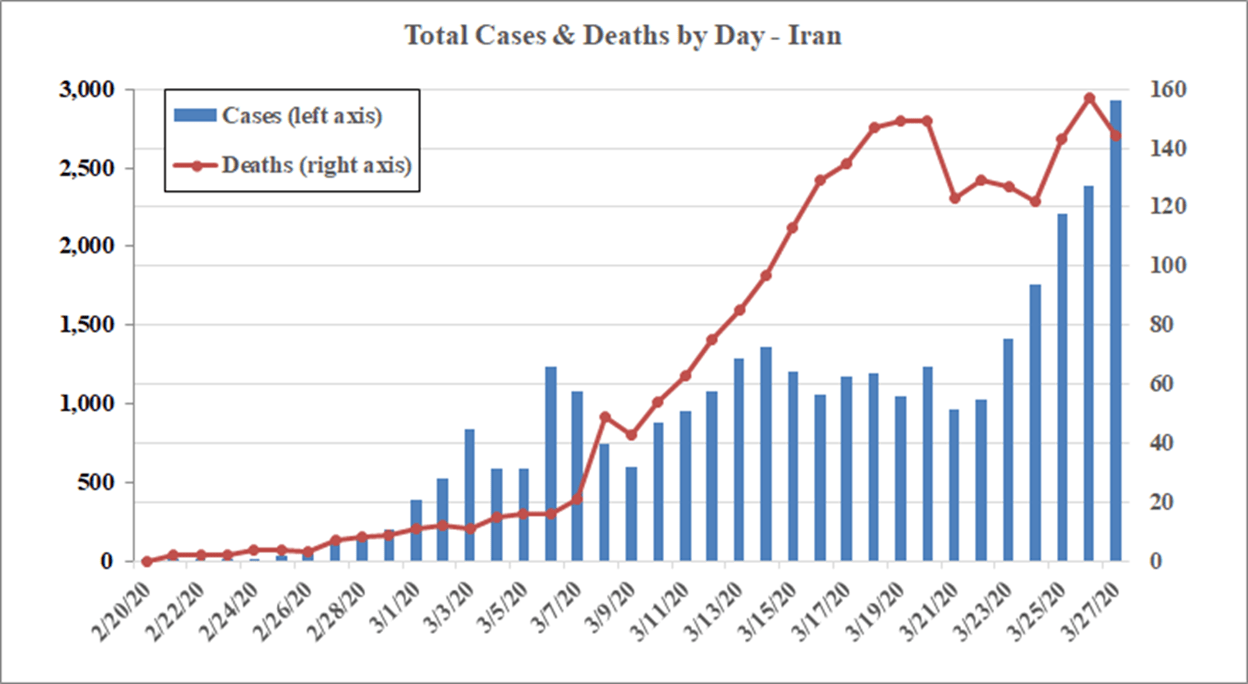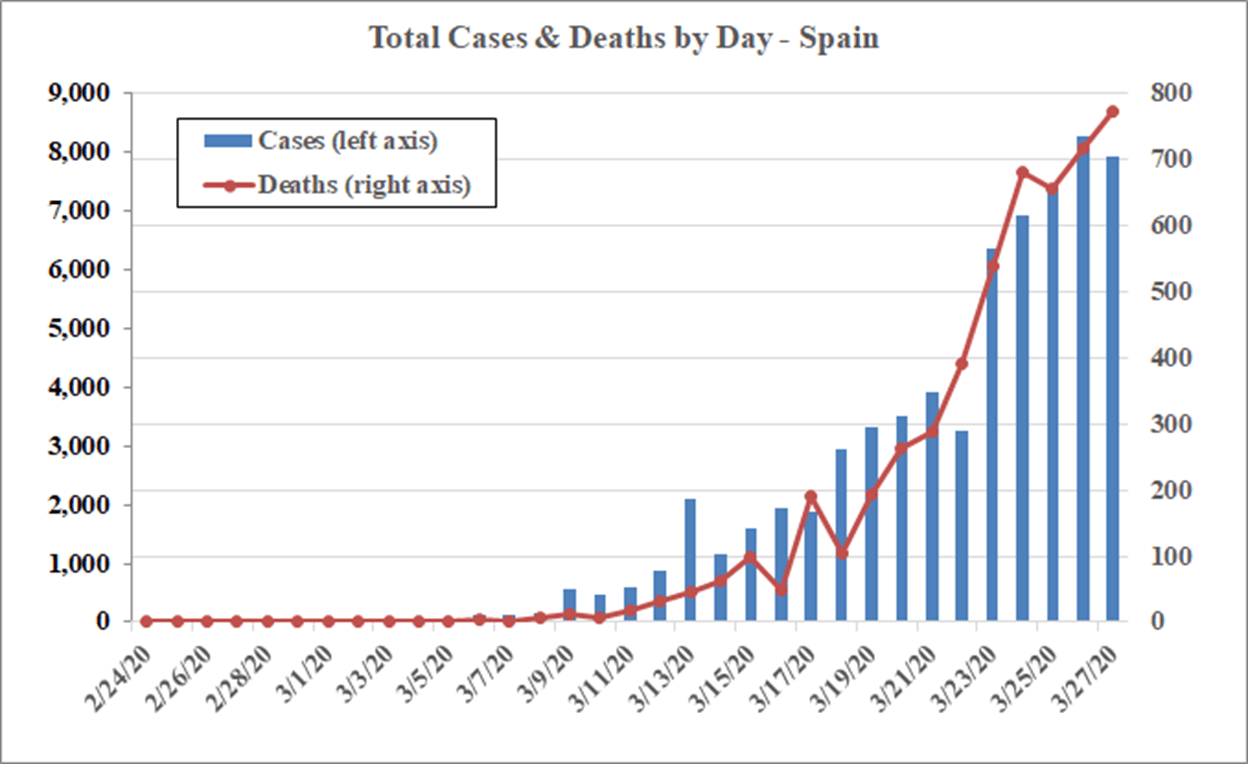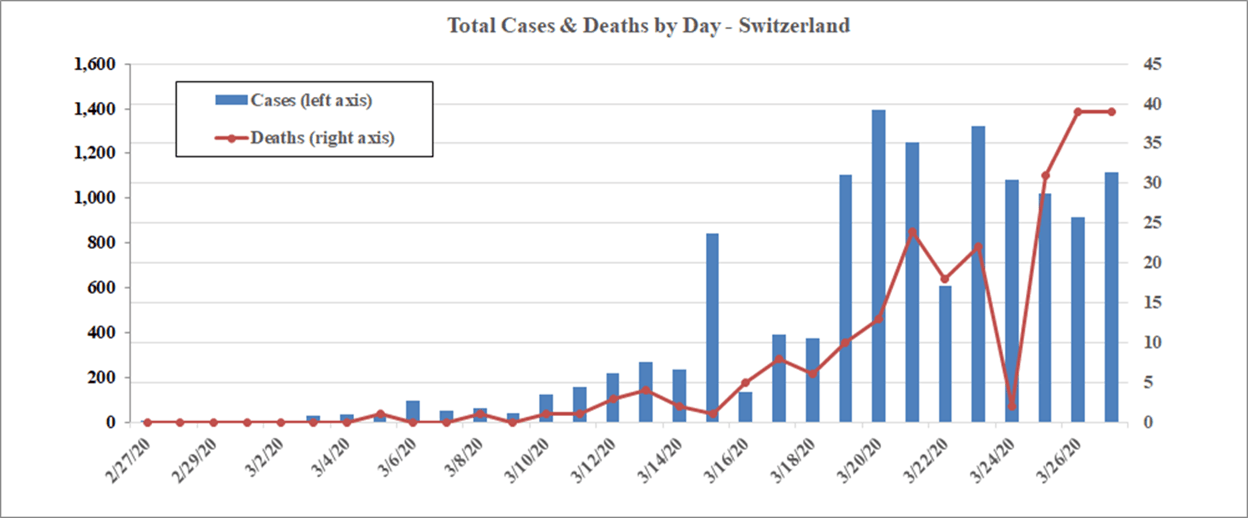Whitney Tilsson’s email to investors discussing how we could solve the coronavirus crisis tomorrow; clinical consequences of covid-19; I’m buying stocks on Monday; Abbott Labs with a GAME CHANGER test; Vo; South Korea; New Rochelle; Positive trends in NYC and NYS; charts from the U.S. and around the world.
Q4 2019 hedge fund letters, conferences and more
1) I hope the provocative subject line got your attention. No, we can’t solve the coronavirus tomorrow – but I think we will soon. This makes me even more confident in the conclusion I made in my report last week, Why I'm Optimistic That We'll Soon Stop the Coronavirus (posted here):
I’m cautiously optimistic that the measures we’ve ramped up over the past couple of weeks are having their desired effect, sharply reducing the coronavirus’ replication rate.
If I’m right, the growth in the number of newly infected Americans is already slowing dramatically – and will soon plateau and then decline, which is exactly what happened in China’s Hubei province, as I discuss below.
This would translate into a range of 10,000 to 20,000 U.S. deaths this year. Every one them is heartbreaking, of course, but to put this in perspective, it would be a small fraction of the 37,000 from traffic fatalities or nearly 150,000 from lung cancer.
As it becomes clear that we’ve controlled the spread of the virus and know exactly where the outbreaks are – which could happen as soon as a couple of weeks from now – we can start bringing our economy back to life.
The combination of the things I outline in my report plus the new stuff below makes me more optimistic about our country and world – and also has important investment implications. Over the past month, I’ve shifted our total net worth (excluding the value of our only non-liquid asset, our apartment) from 15% stocks to 63%... and am going to take that higher on Monday.
Here’s why…
Imagine there was a widely available, cheap, quick, easy, at-home test, similar to a pregnancy test, that would instantly tell you if you’re infected.
In no time, every Americans would know. Then, the few percent who have it could immediately self-quarantine, and everyone else could go back to normal instantly – return to work, go shopping, out to restaurants, even concerts and sporting events.
Why not? There would be no risk to anyone (assuming those who tested positive did, in fact, self-quarantine – an easy problem to solve: if anyone who tested positive was caught somewhere they weren’t supposed to be, they’d be arrested, jailed, and fined half their net worth – we would not fu** around with these a**holes!).
And every week or two, anyone could test themselves to make sure they’re still negative.
Instead, however, because, through yesterday, the U.S. only had done a total of only 686,761 tests, one-sixth the rate of South Korea, we’re blind, thrashing about, and unable to mount an effective defense against this terrible scourge (the failure to ramp up testing sooner is one of the most catastrophic failures in our nation’s history (here’s an article about it: The Lost Month: How a Failure to Test Blinded the U.S. to Covid-19), but I’ll leave that discussion for another email…).
Because we don’t know how many people are infected, where they are, and how rapidly that number is growing, we have no choice but to assume everybody has the virus, so we all have to stay home, virtually all businesses have to shut down, etc.
If you think about it, it’s utter madness – due solely to a lack of testing, we’re self-destructing, crashing our economy. 3.3 million people lost their jobs last week – look at this chart to see how that compares to any period in the past, including the global financial crisis:
I could link to an endless number of articles like these:
- ‘We Have Lost It All’: The Shock Felt by Millions of Unemployed Americans
- Tom Colicchio Spent 19 Years Building a Restaurant Empire. Coronavirus Gutted It in a Month.
I struggle for words to describe what a total calamity this is – and every day it continues, the long-term damage to our economic, political, and social fabric grows. If it hasn’t already, this will soon make the global financial crisis look like child’s play…
So what do we need to do?
TEST EVERYONE AS SOON AS POSSIBLE
This isn’t some pie-in-the sky idea. It’s exactly what they did in Vo, Italy, as I explained in my report:
Finally, let’s look at the little village of Vo, Italy. Amidst the calamity in that country, it’s a tiny bright spot with important lessons for us all.
It’s in the hardest-hit northern part of the country, and had Italy’s first confirmed coronavirus-related death, a 78-year-old man, on February 23. Its response was to test every one of the town’s 3,300 residents, even those with no symptoms. This was critical because most of the 89 residents (2.7%) who tested positive “were completely asymptomatic.”
Rather then sending them to the hospital, where they could spread the disease, they were home-quarantined, told not to go outside or interact with anyone.
Within a mere two weeks, the virus had been virtually eradicated. When every villager was retested, the infection rate had dropped to only 0.41%.
“Ah, but there’s no such test,” you might say. While it’s easy to quickly test (and retest) 3,300 people in Vo, how are we supposed to test 331 million Americans?
In fact, I think it’ll happen sooner than you think. The FDA just approved two tests by Abbott Labs that, while not at-home, will be rapidly deployed across the country in the next week, with the capacity of 50,000 tests per day (1.5 million per month). And the company says that it will soon produce five million tests per month across its two platforms… Former FDA commissioner Scott Gottlieb tweeted that this is a “GAME CHANGER.” I agree.
And that’s just one company. Here’s an article about Abbott, which also mentions other companies that are developing other tests: 'A game changer': FDA authorizes Abbott Labs' portable, 5-minute coronavirus test the size of a toaster. And it’s not just in the U.S. – companies and governments all over the world are working 24/7 on treatments, tests, and vaccines – here are examples:
- U.K. Trials Coronavirus-Immunity Tests for Home Use
- New Virus Test Shortens Wait to 2.5 Hours From Two Days
- Ten-Minute Coronavirus Test Moves Closer to Manufacturing
I think it’s likely that there will soon be the kind of test I mentioned earlier: a widely available, cheap, quick, easy, at-home one, similar to a pregnancy test.
OK, let’s say you’re skeptical that every American will get tested anytime soon. As South Korea has shown, this isn’t necessary. You just have to do fairly widespread testing, focused on the areas with outbreaks. Look at South Korea’s cases and deaths per day (in a country of 51 million people). These are the kind of numbers we want to see: new cases and deaths declining to a minimal number:
But maybe you’re thinking to yourself, “The South Koreans and other Asians, perhaps in large part because they were hit by SARS, MERS, etc., are much more compliant. We rouge Americans will never behave ourselves. Look at all of the people I saw out in Central Park today!”
Well, as this article in today’s NYT notes, one of the places that was hit the first, New Rochelle, NY, already has the virus under control, only two weeks after locking down (exactly the amount of time I’ve predicted it will take for the daily cases to peak nationwide – roughly April 7th I’d estimate): New Rochelle, Once a Coronavirus Hot Spot, May Now Offer Hope. Excerpt:
Two weeks ago, an unexpected cluster of coronavirus cases in New Rochelle, N.Y., seemed an unnerving sign that an outbreak that had devastated China and Italy was taking hold in the New York region and could spread rapidly.
The state took drastic measures that stirred a backlash, including creating a containment zone. But now, the latest data indicates that the measures may be starting to work.
The outbreak, which Gov. Andrew M. Cuomo once said was advancing “unabated” in New Rochelle, has appeared to slow: Over the last four days, only 38 new cases were reported to the county.
“Everybody talks about flattening the curve, and I think that’s exactly what we were able to do in New Rochelle,” said Dr. Sherlita Amler, the Westchester County health commissioner. “We know we can’t stop every single case, but our goal was to reduce the number of cases, and I do think the measures were successful in doing that.”
State and local health officials cautioned that it was too early to declare victory, but the results seemed to show how tough social distancing measures, first adopted here and then imposed around the country, combined with an aggressive testing philosophy, can have an impact on curbing the coronavirus.
Here’s a chart from the article:
In summary, I have more confidence than ever than ever that we will soon get the spread of the coronavirus under control. My best guess is 2-3 million cases in the U.S. this year, leading to 10,000-20,000 deaths – less than a typical year of the flu.
2) Keep in mind, however, that even if I’m right the headlines are will almost certainly be universally bad in the U.S. and Europe for the next week or two. That’s because there’s a lag effect – like a pig in a python.
The virus follows a fairly predictable pattern that can last for more than a month. First, a certain number of people get infected. Then, over many days, some of them begin to show symptoms. Then, more days later, some need to be hospitalized. Finally, often weeks later, the patient either recovers or dies (though a handful suffer long-term issues like lung damage).
Because of this long process, even if the measures we’ve taken in the past couple weeks are working wonderfully, bringing the virus’s replication rate well below 1, we won’t know it initially because we’re not doing widespread testing. In fact, because of those who were infected weeks ago, the number of new cases, hospitalizations, and deaths will almost certainty continue to go up for at least a couple of weeks.
Clinical Consequences Of Covid-19
3) I was glad to see that Dr. Fauci and two of his colleagues think “the overall clinical consequences of Covid-19 may ultimately be more akin to those of a severe seasonal influenza (which has a case fatality rate of approximately 0.1%) or a pandemic influenza (similar to those in 1957 and 1968) rather than a disease similar to SARS or MERS.” Here’s the article they just published in the prestigious New England Journal of Medicine: Covid-19 — Navigating the Uncharted. Excerpt:
On the basis of a case definition requiring a diagnosis of pneumonia, the currently reported case fatality rate is approximately 2%.4 In another article in the Journal, Guan et al.5 report mortality of 1.4% among 1099 patients with laboratory-confirmed Covid-19; these patients had a wide spectrum of disease severity. If one assumes that the number of asymptomatic or minimally symptomatic cases is several times as high as the number of reported cases, the case fatality rate may be considerably less than 1%. This suggests that the overall clinical consequences of Covid-19 may ultimately be more akin to those of a severe seasonal influenza (which has a case fatality rate of approximately 0.1%) or a pandemic influenza (similar to those in 1957 and 1968) rather than a disease similar to SARS or MERS, which have had case fatality rates of 9 to 10% and 36%, respectively.
Positive Trends In NYC And NYS
4) It’s hard to know if this is just short-term statistical noise, but the recent data from New York City and state are very promising. As these four charts show:
a) In NYC, new cases per day are down and deaths per day are flat:
b) NYC hospitalizations per day are way down:
c) NY state tests per day have doubled in the last two days (though tests are down nationally – odd; may be due to bad reporting from WA the last couple of days – see below):
d) The percent of people testing positive in the state declining (though still very high). All GREAT trends!
5) Here’s the weird data the state of Washington is reporting for the past few days in terms of number of tests per day:
6) The latest charts from the states with the most cases…
7) The latest charts from around the world…
Italy’s cases peaked a week ago – great news – but not declining as fast as I’d hope. Deaths hit an all-time high yesterday, but this is (sadly) to be expected (as I explained above, it’s a lagging indicator):
The U.S. doesn’t look good – it needs to start flattening:
The latest “case fatality rates”:
In Germany, cases and deaths are rising rapidly, but from a very low base:
Iran’s cases are rising rapidly (perhaps due to more testing and/or more honest reporting?), but deaths per day have been roughly flat for the last 10 days:
Spain is hurting, but cases per day growth seems to no longer be exponential:
I think Switzerland has clearly flattened the curve:
The UK delayed its lockdown, so it’s still in the early, exponential part of the curve:
Best regards,
Whitney

